Comprehensive Essay on Job Satisfaction: Theories, Models, and Impacts
VerifiedAdded on 2020/03/16
|8
|2232
|112
Essay
AI Summary
This essay delves into the multifaceted concept of job satisfaction, examining various theories and models that attempt to explain its dynamics. It begins by defining job satisfaction and its significance, followed by an exploration of prominent theories such as the affect theory, dispositional approach theory, equity theory, discrepancy theory, two-factor theory, and the job characteristics model. The essay analyzes the core principles of each theory, highlighting the factors that contribute to job satisfaction or dissatisfaction, including workplace environment, supervisor behavior, and individual characteristics. It discusses the impact of job satisfaction on both employees and organizations, emphasizing the importance of understanding and addressing factors that influence it. The essay concludes by summarizing the key insights and emphasizing the need for organizations to prioritize job satisfaction to foster employee well-being and organizational success.
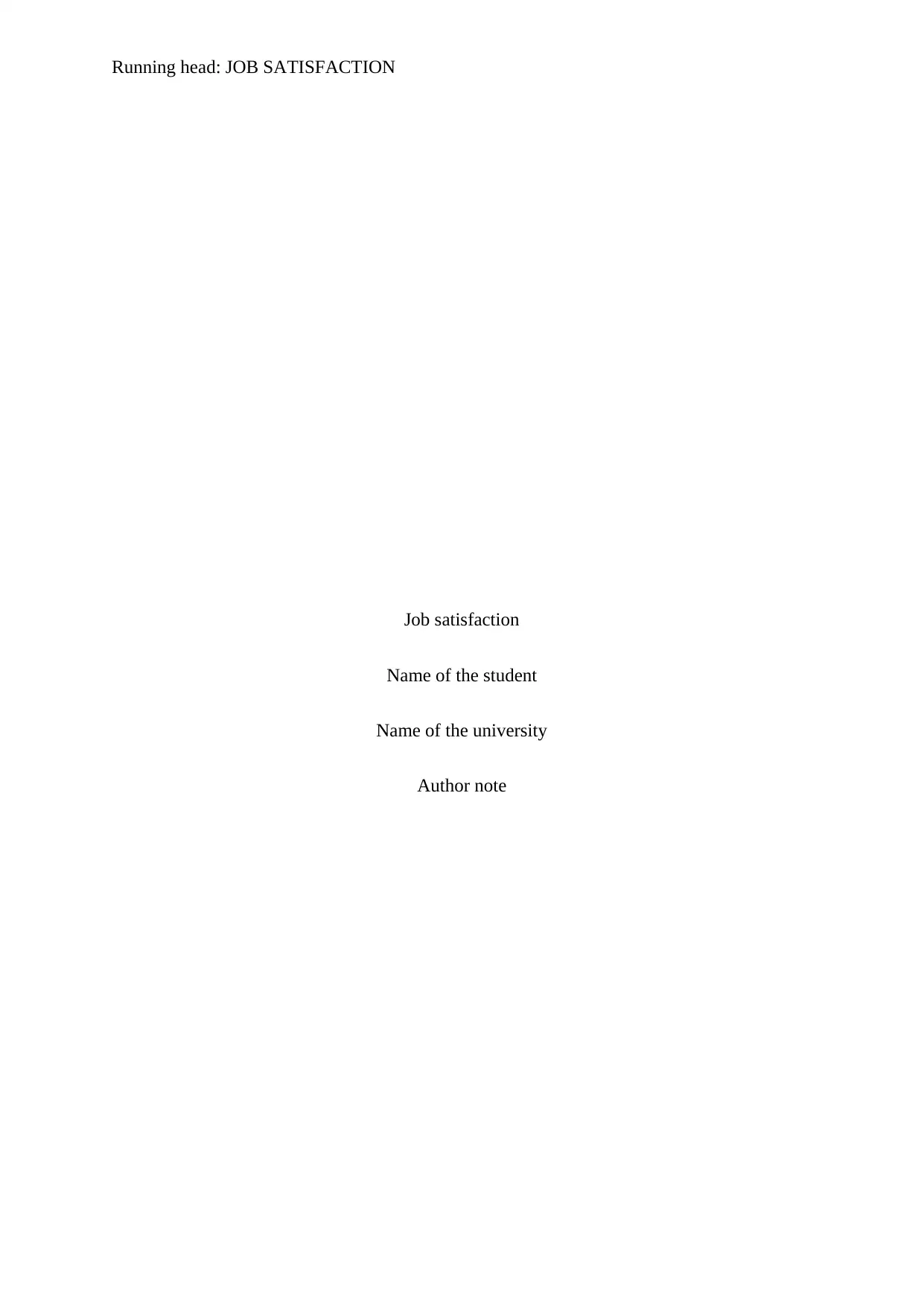
Running head: JOB SATISFACTION
Job satisfaction
Name of the student
Name of the university
Author note
Job satisfaction
Name of the student
Name of the university
Author note
Paraphrase This Document
Need a fresh take? Get an instant paraphrase of this document with our AI Paraphraser
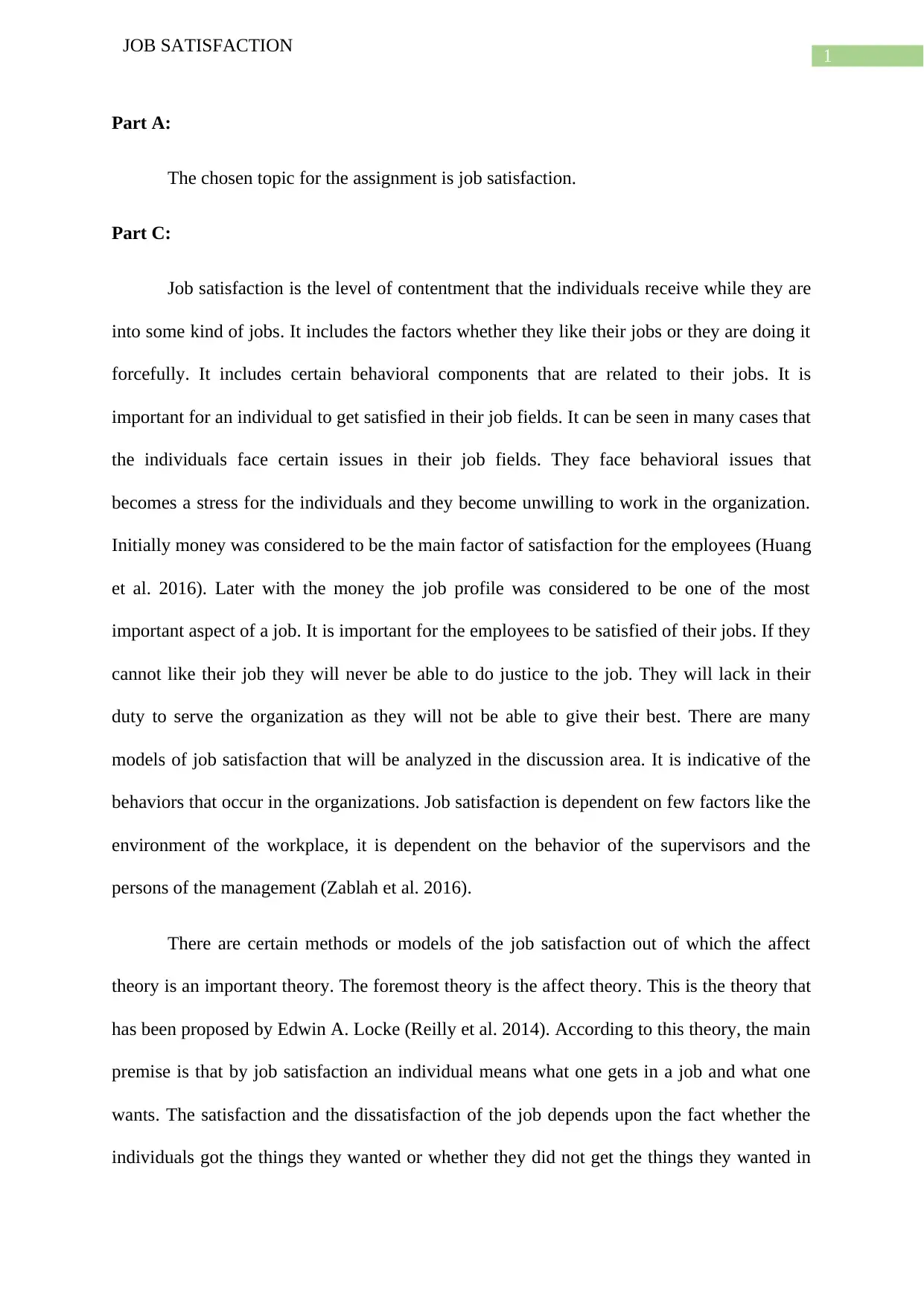
1
JOB SATISFACTION
Part A:
The chosen topic for the assignment is job satisfaction.
Part C:
Job satisfaction is the level of contentment that the individuals receive while they are
into some kind of jobs. It includes the factors whether they like their jobs or they are doing it
forcefully. It includes certain behavioral components that are related to their jobs. It is
important for an individual to get satisfied in their job fields. It can be seen in many cases that
the individuals face certain issues in their job fields. They face behavioral issues that
becomes a stress for the individuals and they become unwilling to work in the organization.
Initially money was considered to be the main factor of satisfaction for the employees (Huang
et al. 2016). Later with the money the job profile was considered to be one of the most
important aspect of a job. It is important for the employees to be satisfied of their jobs. If they
cannot like their job they will never be able to do justice to the job. They will lack in their
duty to serve the organization as they will not be able to give their best. There are many
models of job satisfaction that will be analyzed in the discussion area. It is indicative of the
behaviors that occur in the organizations. Job satisfaction is dependent on few factors like the
environment of the workplace, it is dependent on the behavior of the supervisors and the
persons of the management (Zablah et al. 2016).
There are certain methods or models of the job satisfaction out of which the affect
theory is an important theory. The foremost theory is the affect theory. This is the theory that
has been proposed by Edwin A. Locke (Reilly et al. 2014). According to this theory, the main
premise is that by job satisfaction an individual means what one gets in a job and what one
wants. The satisfaction and the dissatisfaction of the job depends upon the fact whether the
individuals got the things they wanted or whether they did not get the things they wanted in
JOB SATISFACTION
Part A:
The chosen topic for the assignment is job satisfaction.
Part C:
Job satisfaction is the level of contentment that the individuals receive while they are
into some kind of jobs. It includes the factors whether they like their jobs or they are doing it
forcefully. It includes certain behavioral components that are related to their jobs. It is
important for an individual to get satisfied in their job fields. It can be seen in many cases that
the individuals face certain issues in their job fields. They face behavioral issues that
becomes a stress for the individuals and they become unwilling to work in the organization.
Initially money was considered to be the main factor of satisfaction for the employees (Huang
et al. 2016). Later with the money the job profile was considered to be one of the most
important aspect of a job. It is important for the employees to be satisfied of their jobs. If they
cannot like their job they will never be able to do justice to the job. They will lack in their
duty to serve the organization as they will not be able to give their best. There are many
models of job satisfaction that will be analyzed in the discussion area. It is indicative of the
behaviors that occur in the organizations. Job satisfaction is dependent on few factors like the
environment of the workplace, it is dependent on the behavior of the supervisors and the
persons of the management (Zablah et al. 2016).
There are certain methods or models of the job satisfaction out of which the affect
theory is an important theory. The foremost theory is the affect theory. This is the theory that
has been proposed by Edwin A. Locke (Reilly et al. 2014). According to this theory, the main
premise is that by job satisfaction an individual means what one gets in a job and what one
wants. The satisfaction and the dissatisfaction of the job depends upon the fact whether the
individuals got the things they wanted or whether they did not get the things they wanted in
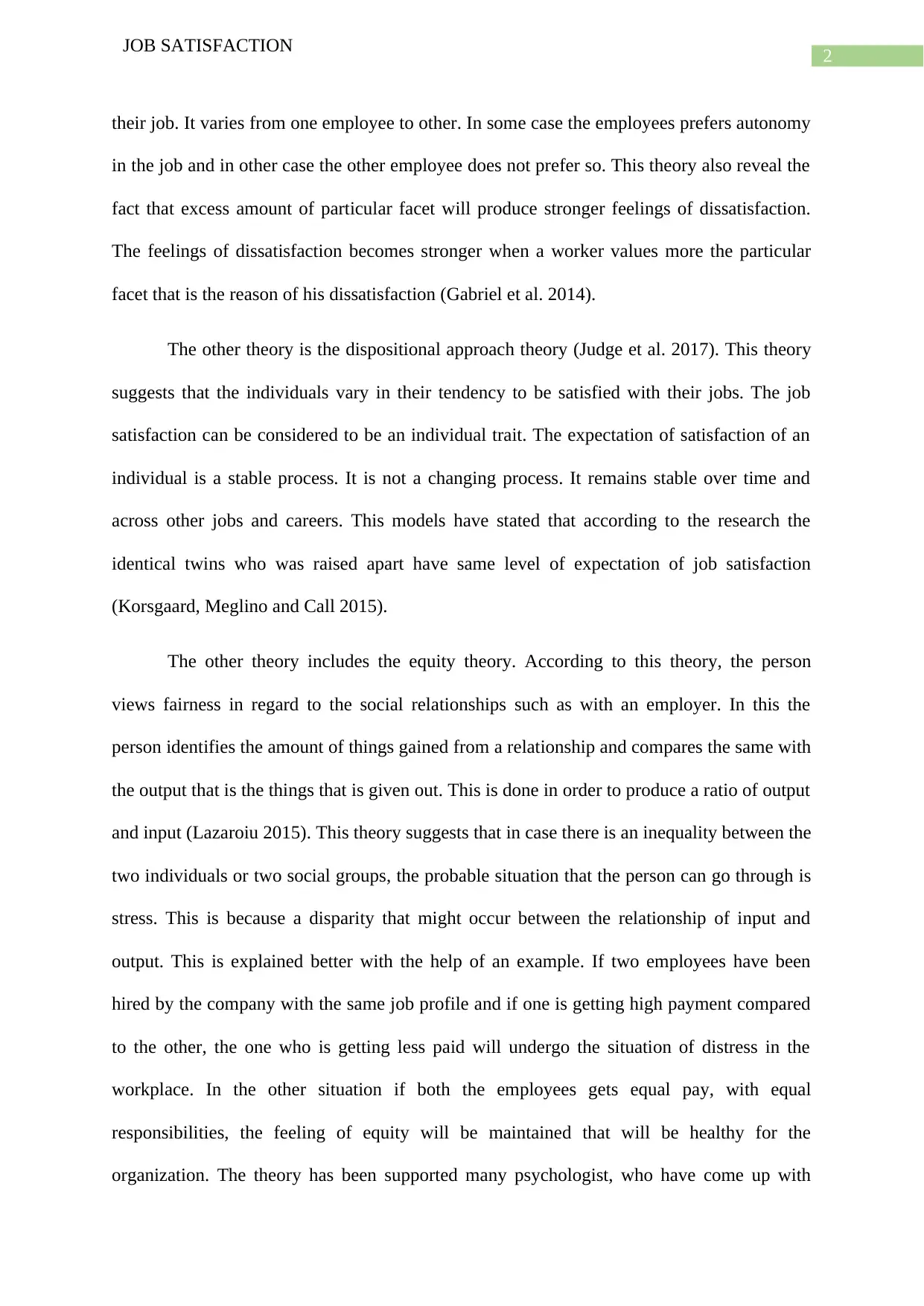
2
JOB SATISFACTION
their job. It varies from one employee to other. In some case the employees prefers autonomy
in the job and in other case the other employee does not prefer so. This theory also reveal the
fact that excess amount of particular facet will produce stronger feelings of dissatisfaction.
The feelings of dissatisfaction becomes stronger when a worker values more the particular
facet that is the reason of his dissatisfaction (Gabriel et al. 2014).
The other theory is the dispositional approach theory (Judge et al. 2017). This theory
suggests that the individuals vary in their tendency to be satisfied with their jobs. The job
satisfaction can be considered to be an individual trait. The expectation of satisfaction of an
individual is a stable process. It is not a changing process. It remains stable over time and
across other jobs and careers. This models have stated that according to the research the
identical twins who was raised apart have same level of expectation of job satisfaction
(Korsgaard, Meglino and Call 2015).
The other theory includes the equity theory. According to this theory, the person
views fairness in regard to the social relationships such as with an employer. In this the
person identifies the amount of things gained from a relationship and compares the same with
the output that is the things that is given out. This is done in order to produce a ratio of output
and input (Lazaroiu 2015). This theory suggests that in case there is an inequality between the
two individuals or two social groups, the probable situation that the person can go through is
stress. This is because a disparity that might occur between the relationship of input and
output. This is explained better with the help of an example. If two employees have been
hired by the company with the same job profile and if one is getting high payment compared
to the other, the one who is getting less paid will undergo the situation of distress in the
workplace. In the other situation if both the employees gets equal pay, with equal
responsibilities, the feeling of equity will be maintained that will be healthy for the
organization. The theory has been supported many psychologist, who have come up with
JOB SATISFACTION
their job. It varies from one employee to other. In some case the employees prefers autonomy
in the job and in other case the other employee does not prefer so. This theory also reveal the
fact that excess amount of particular facet will produce stronger feelings of dissatisfaction.
The feelings of dissatisfaction becomes stronger when a worker values more the particular
facet that is the reason of his dissatisfaction (Gabriel et al. 2014).
The other theory is the dispositional approach theory (Judge et al. 2017). This theory
suggests that the individuals vary in their tendency to be satisfied with their jobs. The job
satisfaction can be considered to be an individual trait. The expectation of satisfaction of an
individual is a stable process. It is not a changing process. It remains stable over time and
across other jobs and careers. This models have stated that according to the research the
identical twins who was raised apart have same level of expectation of job satisfaction
(Korsgaard, Meglino and Call 2015).
The other theory includes the equity theory. According to this theory, the person
views fairness in regard to the social relationships such as with an employer. In this the
person identifies the amount of things gained from a relationship and compares the same with
the output that is the things that is given out. This is done in order to produce a ratio of output
and input (Lazaroiu 2015). This theory suggests that in case there is an inequality between the
two individuals or two social groups, the probable situation that the person can go through is
stress. This is because a disparity that might occur between the relationship of input and
output. This is explained better with the help of an example. If two employees have been
hired by the company with the same job profile and if one is getting high payment compared
to the other, the one who is getting less paid will undergo the situation of distress in the
workplace. In the other situation if both the employees gets equal pay, with equal
responsibilities, the feeling of equity will be maintained that will be healthy for the
organization. The theory has been supported many psychologist, who have come up with
⊘ This is a preview!⊘
Do you want full access?
Subscribe today to unlock all pages.

Trusted by 1+ million students worldwide
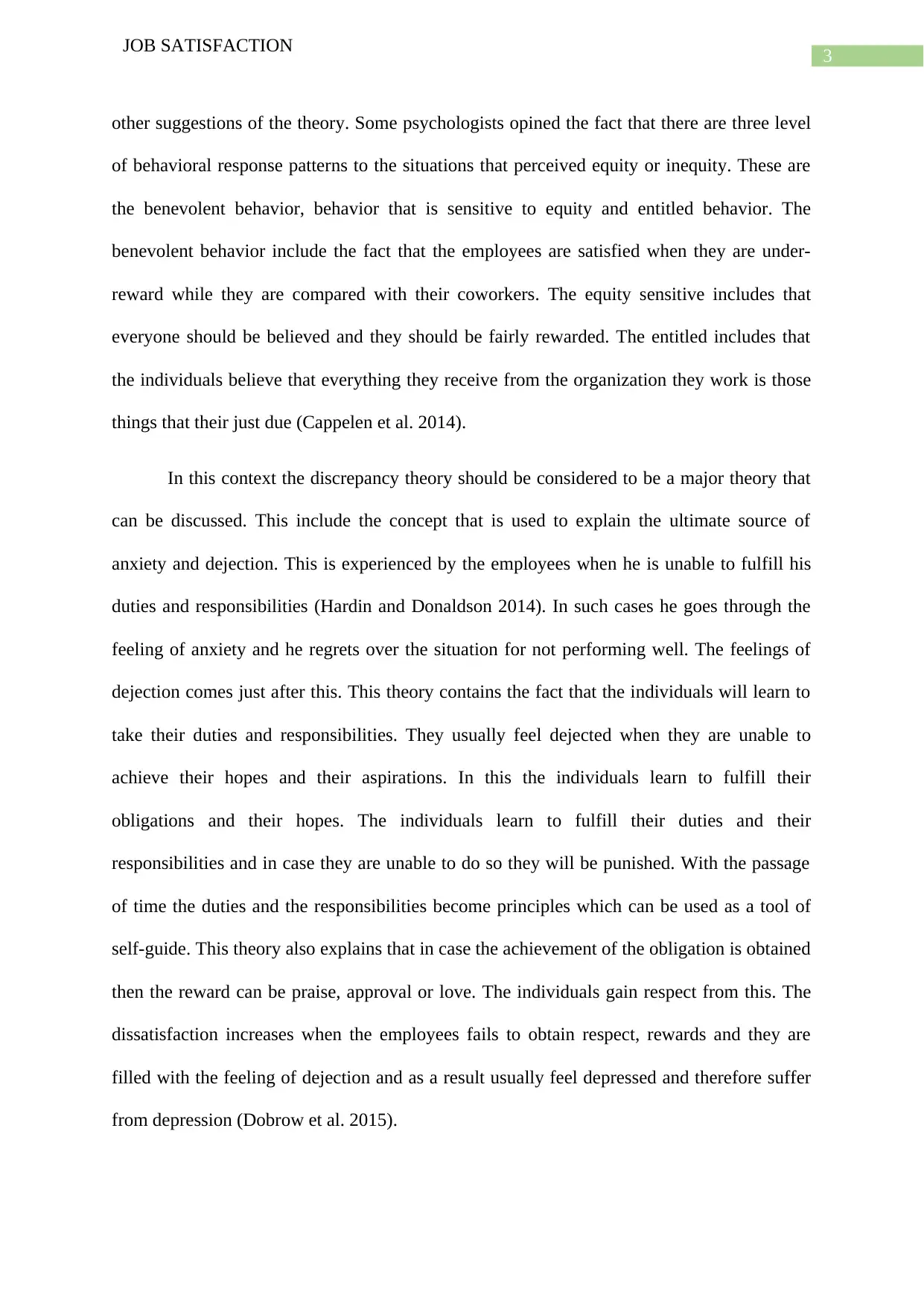
3
JOB SATISFACTION
other suggestions of the theory. Some psychologists opined the fact that there are three level
of behavioral response patterns to the situations that perceived equity or inequity. These are
the benevolent behavior, behavior that is sensitive to equity and entitled behavior. The
benevolent behavior include the fact that the employees are satisfied when they are under-
reward while they are compared with their coworkers. The equity sensitive includes that
everyone should be believed and they should be fairly rewarded. The entitled includes that
the individuals believe that everything they receive from the organization they work is those
things that their just due (Cappelen et al. 2014).
In this context the discrepancy theory should be considered to be a major theory that
can be discussed. This include the concept that is used to explain the ultimate source of
anxiety and dejection. This is experienced by the employees when he is unable to fulfill his
duties and responsibilities (Hardin and Donaldson 2014). In such cases he goes through the
feeling of anxiety and he regrets over the situation for not performing well. The feelings of
dejection comes just after this. This theory contains the fact that the individuals will learn to
take their duties and responsibilities. They usually feel dejected when they are unable to
achieve their hopes and their aspirations. In this the individuals learn to fulfill their
obligations and their hopes. The individuals learn to fulfill their duties and their
responsibilities and in case they are unable to do so they will be punished. With the passage
of time the duties and the responsibilities become principles which can be used as a tool of
self-guide. This theory also explains that in case the achievement of the obligation is obtained
then the reward can be praise, approval or love. The individuals gain respect from this. The
dissatisfaction increases when the employees fails to obtain respect, rewards and they are
filled with the feeling of dejection and as a result usually feel depressed and therefore suffer
from depression (Dobrow et al. 2015).
JOB SATISFACTION
other suggestions of the theory. Some psychologists opined the fact that there are three level
of behavioral response patterns to the situations that perceived equity or inequity. These are
the benevolent behavior, behavior that is sensitive to equity and entitled behavior. The
benevolent behavior include the fact that the employees are satisfied when they are under-
reward while they are compared with their coworkers. The equity sensitive includes that
everyone should be believed and they should be fairly rewarded. The entitled includes that
the individuals believe that everything they receive from the organization they work is those
things that their just due (Cappelen et al. 2014).
In this context the discrepancy theory should be considered to be a major theory that
can be discussed. This include the concept that is used to explain the ultimate source of
anxiety and dejection. This is experienced by the employees when he is unable to fulfill his
duties and responsibilities (Hardin and Donaldson 2014). In such cases he goes through the
feeling of anxiety and he regrets over the situation for not performing well. The feelings of
dejection comes just after this. This theory contains the fact that the individuals will learn to
take their duties and responsibilities. They usually feel dejected when they are unable to
achieve their hopes and their aspirations. In this the individuals learn to fulfill their
obligations and their hopes. The individuals learn to fulfill their duties and their
responsibilities and in case they are unable to do so they will be punished. With the passage
of time the duties and the responsibilities become principles which can be used as a tool of
self-guide. This theory also explains that in case the achievement of the obligation is obtained
then the reward can be praise, approval or love. The individuals gain respect from this. The
dissatisfaction increases when the employees fails to obtain respect, rewards and they are
filled with the feeling of dejection and as a result usually feel depressed and therefore suffer
from depression (Dobrow et al. 2015).
Paraphrase This Document
Need a fresh take? Get an instant paraphrase of this document with our AI Paraphraser
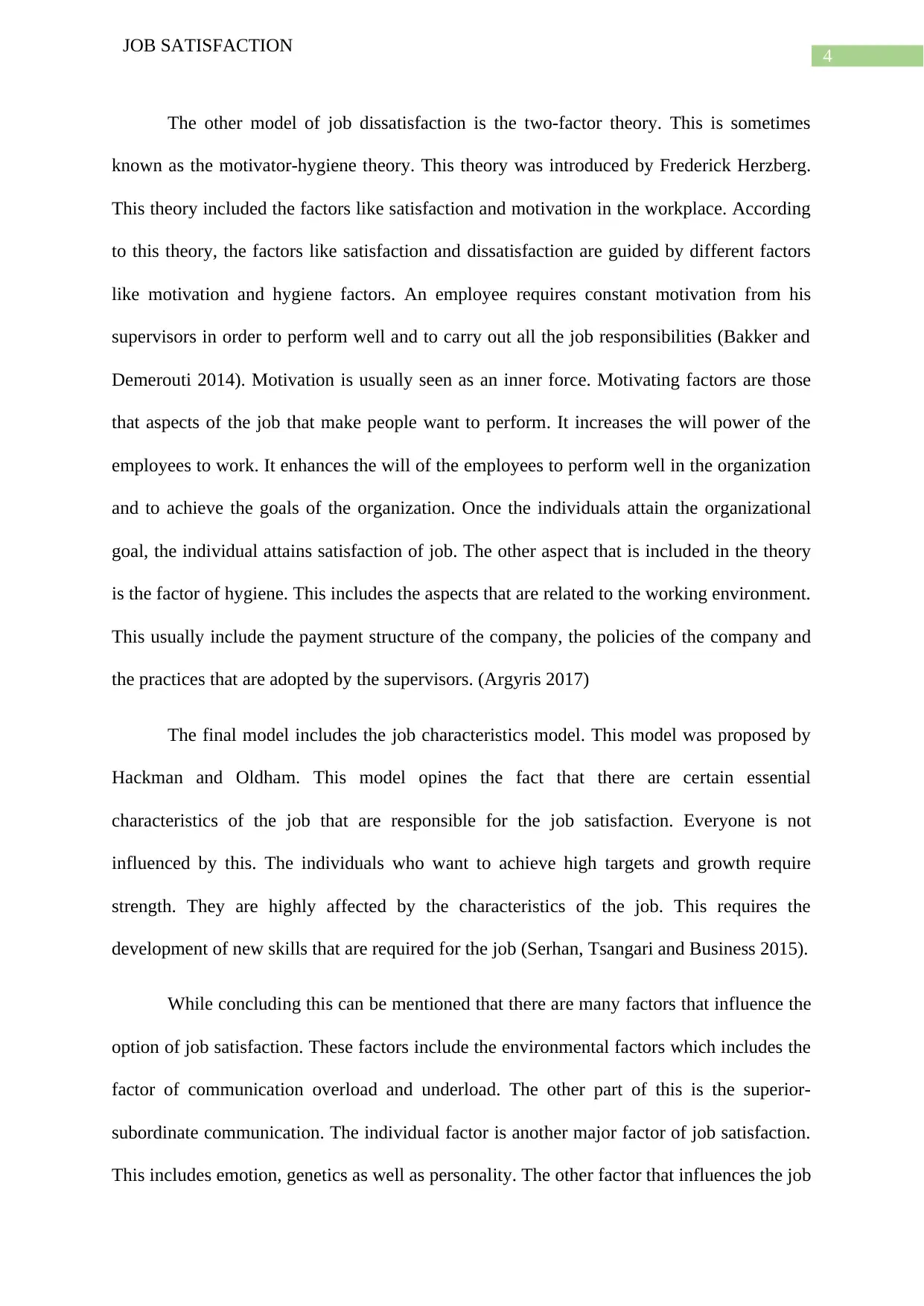
4
JOB SATISFACTION
The other model of job dissatisfaction is the two-factor theory. This is sometimes
known as the motivator-hygiene theory. This theory was introduced by Frederick Herzberg.
This theory included the factors like satisfaction and motivation in the workplace. According
to this theory, the factors like satisfaction and dissatisfaction are guided by different factors
like motivation and hygiene factors. An employee requires constant motivation from his
supervisors in order to perform well and to carry out all the job responsibilities (Bakker and
Demerouti 2014). Motivation is usually seen as an inner force. Motivating factors are those
that aspects of the job that make people want to perform. It increases the will power of the
employees to work. It enhances the will of the employees to perform well in the organization
and to achieve the goals of the organization. Once the individuals attain the organizational
goal, the individual attains satisfaction of job. The other aspect that is included in the theory
is the factor of hygiene. This includes the aspects that are related to the working environment.
This usually include the payment structure of the company, the policies of the company and
the practices that are adopted by the supervisors. (Argyris 2017)
The final model includes the job characteristics model. This model was proposed by
Hackman and Oldham. This model opines the fact that there are certain essential
characteristics of the job that are responsible for the job satisfaction. Everyone is not
influenced by this. The individuals who want to achieve high targets and growth require
strength. They are highly affected by the characteristics of the job. This requires the
development of new skills that are required for the job (Serhan, Tsangari and Business 2015).
While concluding this can be mentioned that there are many factors that influence the
option of job satisfaction. These factors include the environmental factors which includes the
factor of communication overload and underload. The other part of this is the superior-
subordinate communication. The individual factor is another major factor of job satisfaction.
This includes emotion, genetics as well as personality. The other factor that influences the job
JOB SATISFACTION
The other model of job dissatisfaction is the two-factor theory. This is sometimes
known as the motivator-hygiene theory. This theory was introduced by Frederick Herzberg.
This theory included the factors like satisfaction and motivation in the workplace. According
to this theory, the factors like satisfaction and dissatisfaction are guided by different factors
like motivation and hygiene factors. An employee requires constant motivation from his
supervisors in order to perform well and to carry out all the job responsibilities (Bakker and
Demerouti 2014). Motivation is usually seen as an inner force. Motivating factors are those
that aspects of the job that make people want to perform. It increases the will power of the
employees to work. It enhances the will of the employees to perform well in the organization
and to achieve the goals of the organization. Once the individuals attain the organizational
goal, the individual attains satisfaction of job. The other aspect that is included in the theory
is the factor of hygiene. This includes the aspects that are related to the working environment.
This usually include the payment structure of the company, the policies of the company and
the practices that are adopted by the supervisors. (Argyris 2017)
The final model includes the job characteristics model. This model was proposed by
Hackman and Oldham. This model opines the fact that there are certain essential
characteristics of the job that are responsible for the job satisfaction. Everyone is not
influenced by this. The individuals who want to achieve high targets and growth require
strength. They are highly affected by the characteristics of the job. This requires the
development of new skills that are required for the job (Serhan, Tsangari and Business 2015).
While concluding this can be mentioned that there are many factors that influence the
option of job satisfaction. These factors include the environmental factors which includes the
factor of communication overload and underload. The other part of this is the superior-
subordinate communication. The individual factor is another major factor of job satisfaction.
This includes emotion, genetics as well as personality. The other factor that influences the job
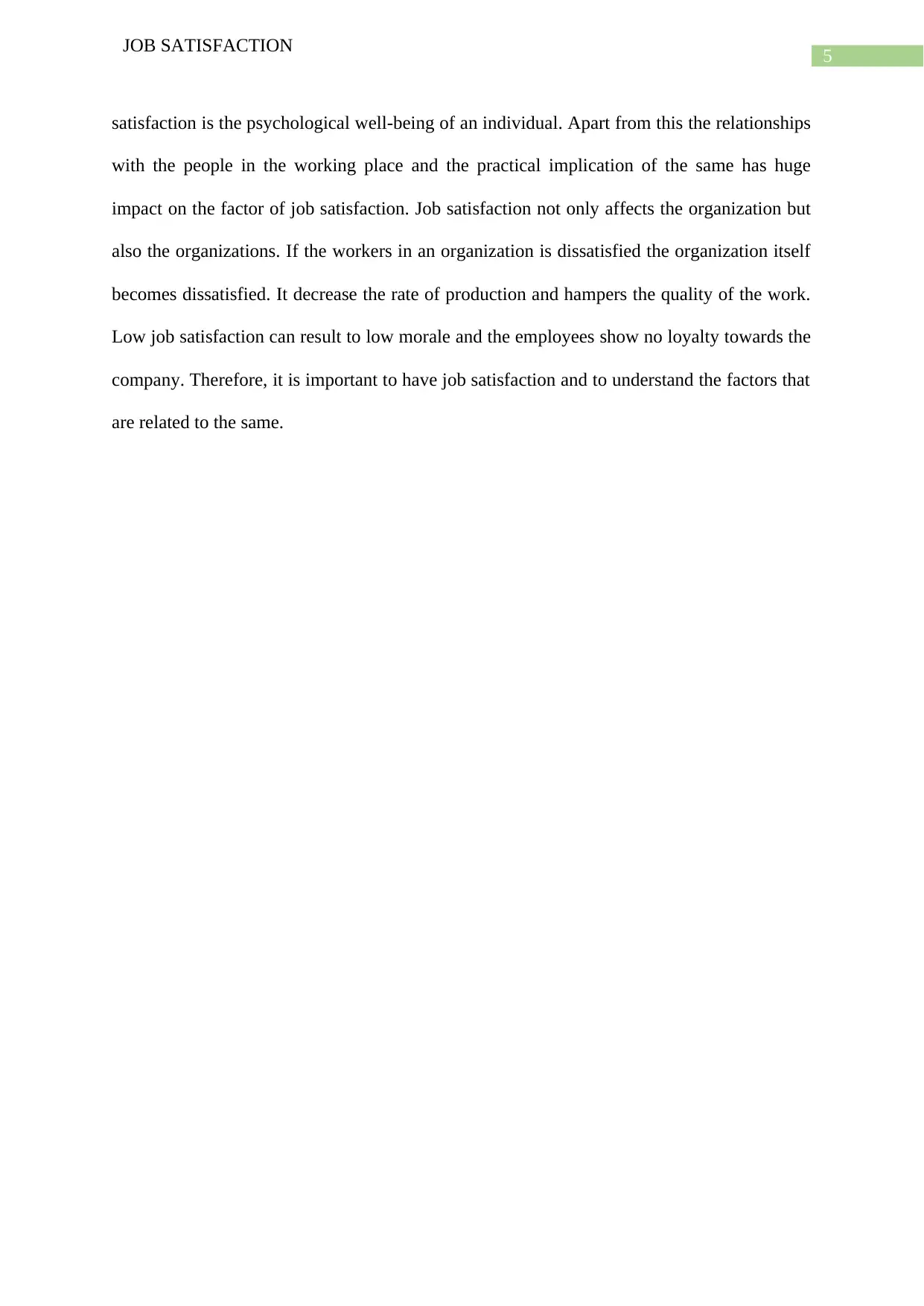
5
JOB SATISFACTION
satisfaction is the psychological well-being of an individual. Apart from this the relationships
with the people in the working place and the practical implication of the same has huge
impact on the factor of job satisfaction. Job satisfaction not only affects the organization but
also the organizations. If the workers in an organization is dissatisfied the organization itself
becomes dissatisfied. It decrease the rate of production and hampers the quality of the work.
Low job satisfaction can result to low morale and the employees show no loyalty towards the
company. Therefore, it is important to have job satisfaction and to understand the factors that
are related to the same.
JOB SATISFACTION
satisfaction is the psychological well-being of an individual. Apart from this the relationships
with the people in the working place and the practical implication of the same has huge
impact on the factor of job satisfaction. Job satisfaction not only affects the organization but
also the organizations. If the workers in an organization is dissatisfied the organization itself
becomes dissatisfied. It decrease the rate of production and hampers the quality of the work.
Low job satisfaction can result to low morale and the employees show no loyalty towards the
company. Therefore, it is important to have job satisfaction and to understand the factors that
are related to the same.
⊘ This is a preview!⊘
Do you want full access?
Subscribe today to unlock all pages.

Trusted by 1+ million students worldwide
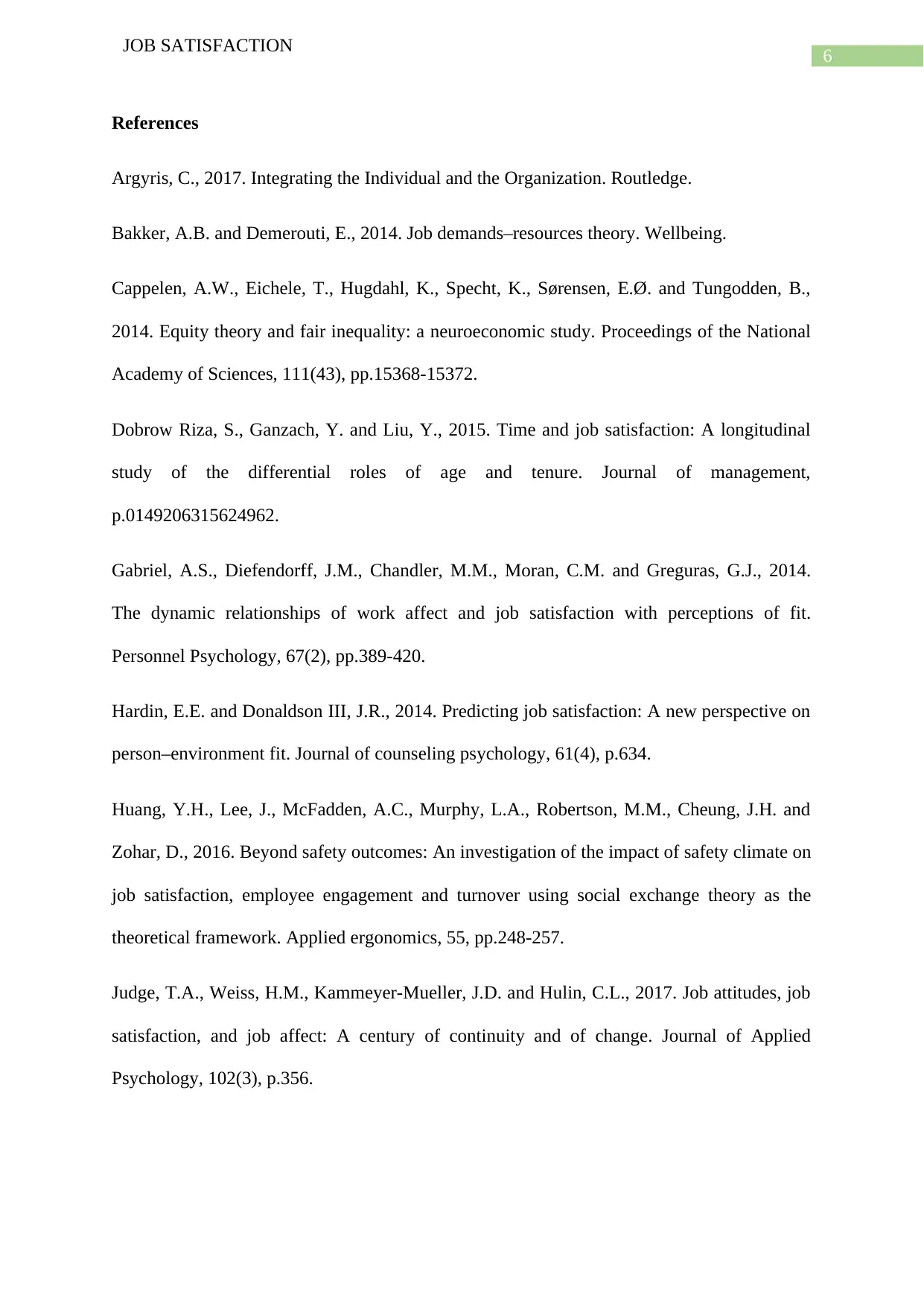
6
JOB SATISFACTION
References
Argyris, C., 2017. Integrating the Individual and the Organization. Routledge.
Bakker, A.B. and Demerouti, E., 2014. Job demands–resources theory. Wellbeing.
Cappelen, A.W., Eichele, T., Hugdahl, K., Specht, K., Sørensen, E.Ø. and Tungodden, B.,
2014. Equity theory and fair inequality: a neuroeconomic study. Proceedings of the National
Academy of Sciences, 111(43), pp.15368-15372.
Dobrow Riza, S., Ganzach, Y. and Liu, Y., 2015. Time and job satisfaction: A longitudinal
study of the differential roles of age and tenure. Journal of management,
p.0149206315624962.
Gabriel, A.S., Diefendorff, J.M., Chandler, M.M., Moran, C.M. and Greguras, G.J., 2014.
The dynamic relationships of work affect and job satisfaction with perceptions of fit.
Personnel Psychology, 67(2), pp.389-420.
Hardin, E.E. and Donaldson III, J.R., 2014. Predicting job satisfaction: A new perspective on
person–environment fit. Journal of counseling psychology, 61(4), p.634.
Huang, Y.H., Lee, J., McFadden, A.C., Murphy, L.A., Robertson, M.M., Cheung, J.H. and
Zohar, D., 2016. Beyond safety outcomes: An investigation of the impact of safety climate on
job satisfaction, employee engagement and turnover using social exchange theory as the
theoretical framework. Applied ergonomics, 55, pp.248-257.
Judge, T.A., Weiss, H.M., Kammeyer-Mueller, J.D. and Hulin, C.L., 2017. Job attitudes, job
satisfaction, and job affect: A century of continuity and of change. Journal of Applied
Psychology, 102(3), p.356.
JOB SATISFACTION
References
Argyris, C., 2017. Integrating the Individual and the Organization. Routledge.
Bakker, A.B. and Demerouti, E., 2014. Job demands–resources theory. Wellbeing.
Cappelen, A.W., Eichele, T., Hugdahl, K., Specht, K., Sørensen, E.Ø. and Tungodden, B.,
2014. Equity theory and fair inequality: a neuroeconomic study. Proceedings of the National
Academy of Sciences, 111(43), pp.15368-15372.
Dobrow Riza, S., Ganzach, Y. and Liu, Y., 2015. Time and job satisfaction: A longitudinal
study of the differential roles of age and tenure. Journal of management,
p.0149206315624962.
Gabriel, A.S., Diefendorff, J.M., Chandler, M.M., Moran, C.M. and Greguras, G.J., 2014.
The dynamic relationships of work affect and job satisfaction with perceptions of fit.
Personnel Psychology, 67(2), pp.389-420.
Hardin, E.E. and Donaldson III, J.R., 2014. Predicting job satisfaction: A new perspective on
person–environment fit. Journal of counseling psychology, 61(4), p.634.
Huang, Y.H., Lee, J., McFadden, A.C., Murphy, L.A., Robertson, M.M., Cheung, J.H. and
Zohar, D., 2016. Beyond safety outcomes: An investigation of the impact of safety climate on
job satisfaction, employee engagement and turnover using social exchange theory as the
theoretical framework. Applied ergonomics, 55, pp.248-257.
Judge, T.A., Weiss, H.M., Kammeyer-Mueller, J.D. and Hulin, C.L., 2017. Job attitudes, job
satisfaction, and job affect: A century of continuity and of change. Journal of Applied
Psychology, 102(3), p.356.
Paraphrase This Document
Need a fresh take? Get an instant paraphrase of this document with our AI Paraphraser
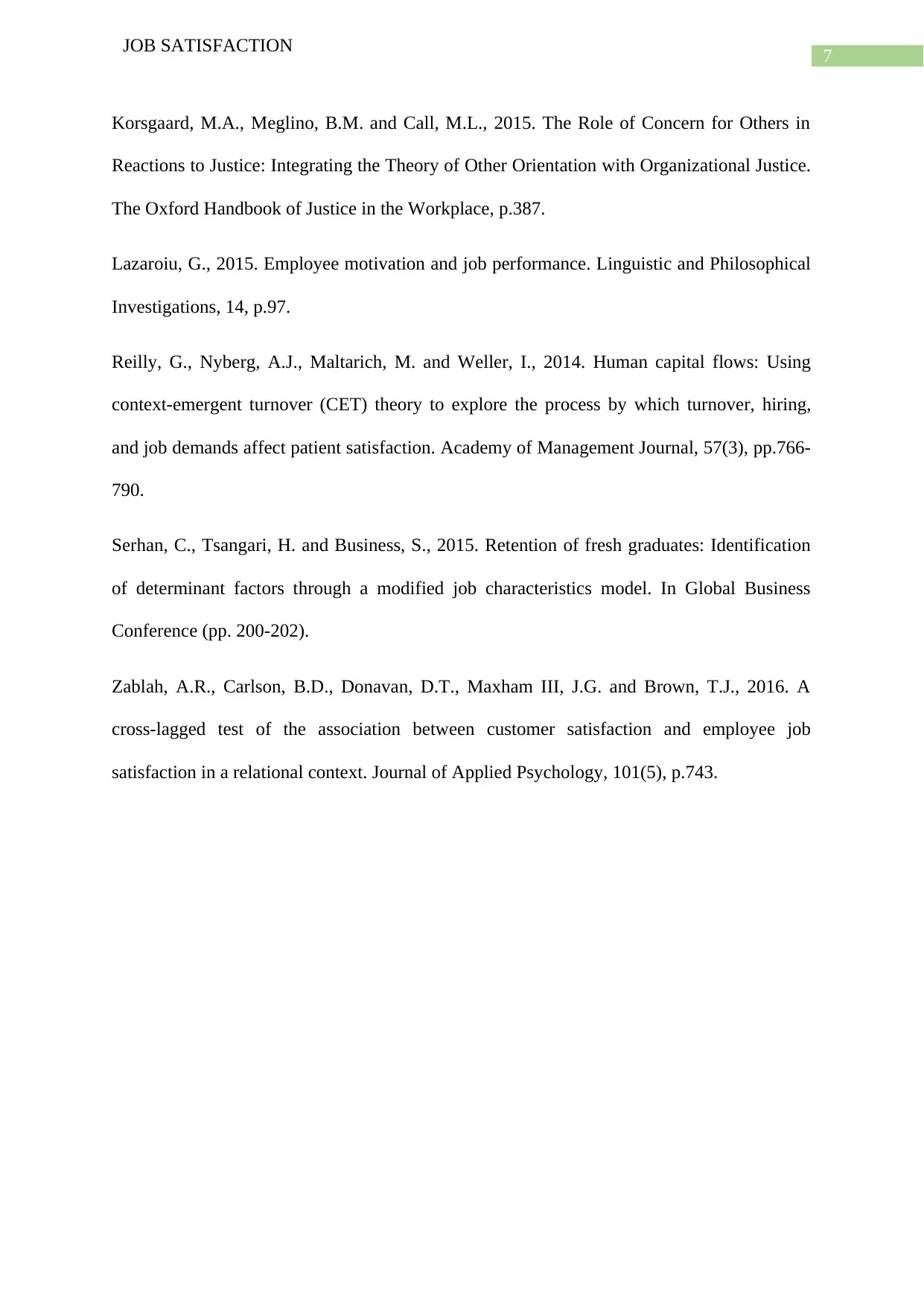
7
JOB SATISFACTION
Korsgaard, M.A., Meglino, B.M. and Call, M.L., 2015. The Role of Concern for Others in
Reactions to Justice: Integrating the Theory of Other Orientation with Organizational Justice.
The Oxford Handbook of Justice in the Workplace, p.387.
Lazaroiu, G., 2015. Employee motivation and job performance. Linguistic and Philosophical
Investigations, 14, p.97.
Reilly, G., Nyberg, A.J., Maltarich, M. and Weller, I., 2014. Human capital flows: Using
context-emergent turnover (CET) theory to explore the process by which turnover, hiring,
and job demands affect patient satisfaction. Academy of Management Journal, 57(3), pp.766-
790.
Serhan, C., Tsangari, H. and Business, S., 2015. Retention of fresh graduates: Identification
of determinant factors through a modified job characteristics model. In Global Business
Conference (pp. 200-202).
Zablah, A.R., Carlson, B.D., Donavan, D.T., Maxham III, J.G. and Brown, T.J., 2016. A
cross-lagged test of the association between customer satisfaction and employee job
satisfaction in a relational context. Journal of Applied Psychology, 101(5), p.743.
JOB SATISFACTION
Korsgaard, M.A., Meglino, B.M. and Call, M.L., 2015. The Role of Concern for Others in
Reactions to Justice: Integrating the Theory of Other Orientation with Organizational Justice.
The Oxford Handbook of Justice in the Workplace, p.387.
Lazaroiu, G., 2015. Employee motivation and job performance. Linguistic and Philosophical
Investigations, 14, p.97.
Reilly, G., Nyberg, A.J., Maltarich, M. and Weller, I., 2014. Human capital flows: Using
context-emergent turnover (CET) theory to explore the process by which turnover, hiring,
and job demands affect patient satisfaction. Academy of Management Journal, 57(3), pp.766-
790.
Serhan, C., Tsangari, H. and Business, S., 2015. Retention of fresh graduates: Identification
of determinant factors through a modified job characteristics model. In Global Business
Conference (pp. 200-202).
Zablah, A.R., Carlson, B.D., Donavan, D.T., Maxham III, J.G. and Brown, T.J., 2016. A
cross-lagged test of the association between customer satisfaction and employee job
satisfaction in a relational context. Journal of Applied Psychology, 101(5), p.743.
1 out of 8
Related Documents
Your All-in-One AI-Powered Toolkit for Academic Success.
+13062052269
info@desklib.com
Available 24*7 on WhatsApp / Email
![[object Object]](/_next/static/media/star-bottom.7253800d.svg)
Unlock your academic potential
Copyright © 2020–2025 A2Z Services. All Rights Reserved. Developed and managed by ZUCOL.




